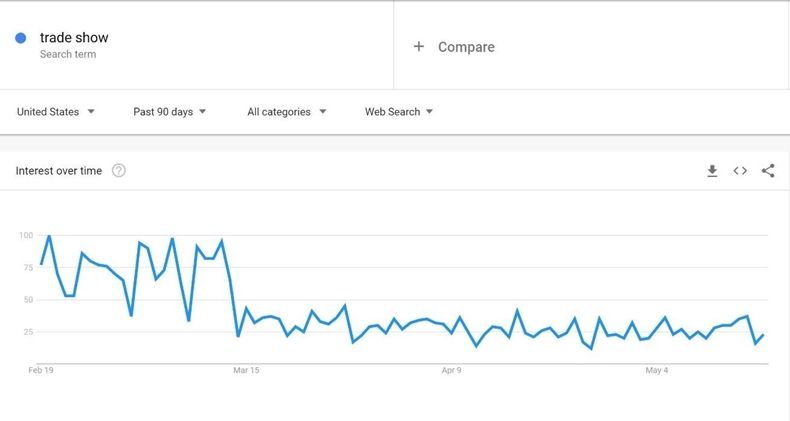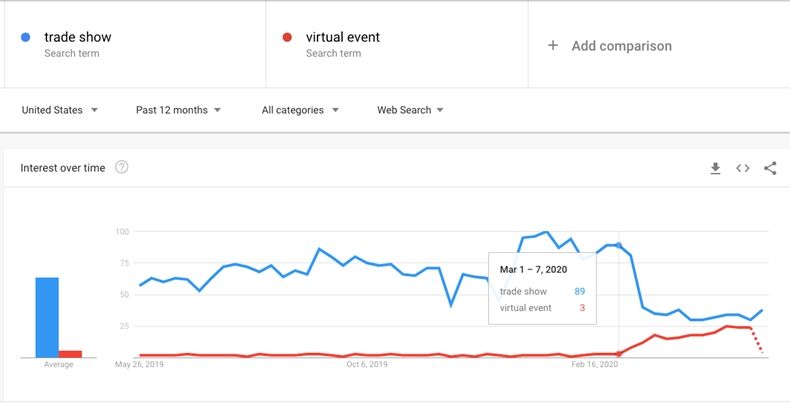Creating B2B marketing content during a crisis is a challenge, and that challenge increases 100-fold when the world is suffering through a pandemic.
Far from giving up, however, some B2B marketers are finding creative new ways to spread brand awareness.
Others are looking to pivot their marketing strategies to adapt to the current situation.
One of the primary ways that marketers can determine how to make a difference in this environment is to look at the trends in online searches.
In this article, we look at how analyzing critical search data trends can help marketers generate consistent content that will improve traffic and boost sales.
1. What is Critical Data in the Current Context?
Businesses, customers, and clients are all spending more time online, which should therefore be a source for maintaining the flow of revenue.
Because more businesses are online, we can infer they are using online searches—because they need to get news and information, and also find new ways to reach customers.
Search data is valuable for B2B companies, as it tells us where we need to be—on social media, blogs, vlogs... But it is also important for B2B marketers to know why potential clients are on these channels.
With the increase in remote teams, businesses are now trying to stay connected using online tools.
When marketers begin looking at data through the lens of their audience's behavior, they will be able to make critical analyses that will help them generate content.
So how can marketers conduct such an analysis during this crisis, and also how can that analysis be used to create content?
2. Sifting Through Critical Data
If you look at search trends within your industry, you will likely notice one disappointing fact: Most of the search terms you have been optimizing your content for have fallen in rankings.
That means people aren't looking for content using your chosen keywords. But it doesn't mean that consumers aren't interested in your content or your products.
For instance, if you look at trends for the search term "trade show," you can see how much they searches plummeted from February to May 2020:

This is worrying for businesses—not merely because it means their clientele isn't looking for them, but also because it means revenue is going to be decreasing.
But now look at the search term "virtual event" in comparison with "trade show":

There has seen a noticeable rise in the same period.
A similar, though less prominent, increase is apparent for the term "online event":

So all that is where the critical data comes in.
We can infer from these trends that tradeshows haven't gone out of fashion, but people aren't traveling or even going outside... so they would rather attend online events instead.
By understanding this change in behavior, businesses can clue in to the new needs of their audiences and begin to generate content accordingly.
3. Analyzing Content Opportunities
After beginning to understand how search trends are changing in the current environment and what that could mean for you, you next need to analyze them a bit further so that you can use the data to inform your SEO content marketing needs.
Let's take the tradeshow example from above and consider it further.
The downward trend in the term "trade show" tells us that businesses can't attend shows because live in-person events have been canceled as a result of the pandemic. That means creating content using keywords relevant to those events isn't going to get you traction.
You will continue to rank for the term because of great SEO, but that won't result in more attendees or more purchases of booths because people aren't looking for you anymore.
If you want your clients to find you, you need to pivot on the keywords you use.
Admittedly, that is not an easy exercise: The marketing team will have spent a long time planning these keywords. But past strategies won't work for the pandemic (or other major crises), so changes need to be made.
Look at all the possible alternatives that people could be searching for instead of "trade show." If people still want to build partnerships in their industry but can't go out to do so, what will they be looking for instead?
That gap is where your content opportunities lie.
But to generate the right kind of content with the new information and insights you glean, you need to set yourself new goals.
4. Customer Behavior
Most companies have one goal: sell products or services and bring in revenue to keep the business going.
But there are smaller goals that allow businesses to reach that overarching sales target, such as increasing social media followers and boosting website traffic.
During a crisis like the one we are facing, it is important to look at more than just the goals for your company.
You need to look at your clients' goals: What do they want and how do they want to get it?
If we once again look at the tradeshow example, we can start to understand our audience's goals:
- They want the sense of normality that comes with attending industry events.
- They need to create partnerships to ensure the longevity of their business.
- They want new and accessible methods of continuing business practices while social-distancing.
Once you determine what your client base needs, you can start examining how you can provide content that delivers related information to them.
For instance, because people want to attend events, you know that they want to learn how to connect with other businesses, or how to create a virtual show for their own client base.
That is the kind of content you might create for them.
5. Generating Content
You now have the tools to begin generating content that will help your business thrive in crisis times.
Use alternate search terms that have now become popular to brainstorm content ideas.
Our example tradeshow's fictional marketers might create blog posts around creating online tradeshows, connecting with businesses digitally, and earning revenue from alternative digital sources. They might also create presentation templates to share virtual event production tips with fellow businesses or event organizers.
To make the process easier, they might also look for examples from other tradeshows or event-based businesses to see what kind of content they are generating.
The goal is to use your content to solve a problem being faced by your client base now. It's not just to sell your products.
If you keep that in mind, you will be able to create content that will be accessible and successful.
Data and Content Creation Go Hand-in-Hand
During an unprecedented crisis like this pandemic, everything can seem like the end of the world.
But by using readily available data and analyzing it thoroughly, you can create content that will reach your audience and help you maintain your sources of revenue.




